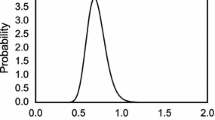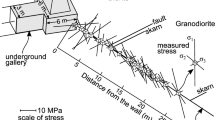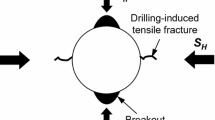Abstract
Many subsurface engineering applications require accurate knowledge of the in-situ state of stress for their safe design and operation. Existing methods to meet this need primarily include field measurements for estimating one or more of the principal stresses from a borehole, or optimization methods for constructing a 3D geomechanical model in terms of geophysical measurements. These methods, however, often contain considerable uncertainty in estimating the state of stress. In this paper, we build on a Bayesian approach to quantify uncertainty in stress estimations for subsurface engineering applications. This approach can provide an estimate of the 3D distribution of stress throughout the volume of interest and provide an estimate of the uncertainty arising from the stress measurement, the rheology parameters, and a paucity of measurements. The value of this approach is demonstrated using stress measurements from the In Salah carbon storage site, which was one of the world’s first industrial carbon capture and storage projects. This demonstration shows the application of this Bayesian approach for estimating the initial state of stress for In Salah and quantifying the uncertainty in the estimated stress. Also, an assessment of a maximum injection pressure to prevent geomechanical risks from CO2 injection pressures is provided in terms of the probability distribution of the minimum principal stress quantified by the approach. With the In Salah case study, this paper demonstrates that using the Bayesian approach can provide additional insights for site explorations and/or project operations to make informed-site decisions for subsurface engineering applications.
Highlights
-
This study proposes a Bayesian approach to quantify uncertainty in estimates of initial 3D stress distributions arising from different sources.
-
The approach provides the joint probability of the two horizontal principal stresses, instead of only the mean stress state of each.
-
Adding regional geologic information and stress-related informative priors can reduce uncertainty in estimates of stress and modeling parameters.
-
The approach helps make more reliable geomechanical decisions for subsurface engineering applications compared to a deterministic method.

adapted from White et al. (2014)]













Similar content being viewed by others
Abbreviations
- \({\varvec{x}}\) :
-
List of uncertain parameters
- \(P_{p}\) :
-
Effective pore pressure
- \(\sigma_{h}\) :
-
Total minimum principal stress
- \(\rho_{r}\) :
-
Rock density
- \(\sigma_{H}\) :
-
Total maximum principal stress
- \({{\varvec{\updelta}}}\) :
-
Kronecker delta
- \(\sigma_{v}\) :
-
Total vertical stress
- \(\alpha\) :
-
Biot’s coefficient
- \(\varepsilon_{h}\) :
-
Minimum horizontal strain
- \({\mathbf{C}}\) :
-
Stiffness tensor
- \(\varepsilon_{H}\) :
-
Maximum horizontal strain
- E :
-
Young’s modulus
- \({\varvec{\sigma}}\) :
-
Total stress tensor
- ν :
-
Poisson’s ratio
- \({\varvec{\varepsilon}}\) :
-
Strain tensor
- \({\varvec{D}}\) :
-
Given information for \({\varvec{x}}\)
- \(L_{l}\) :
-
Lower bound
- \(\theta\) :
-
Mean
- \(L_{u}\) :
-
Upper bound
- \(\xi\) :
-
Standard deviation
- \(\mu\) :
-
Friction coefficient
References
Bao T, Burghardt J, Gupta V, Edelman E, McPherson B, White M (2021a) Experimental workflow to estimate model parameters for evaluating long term viscoelastic response of CO2 storage caprocks. Int J Rock Mech Min Sci 146:104796
Bao T, Burghardt J, Gupta V, White M (2021b) Impact of time-dependent deformation on geomechanical risk for geologic carbon storage. Int J Rock Mech Min Sci 148:104940
Bayes T (1763) LII. An essay towards solving a problem in the doctrine of chances. By the late Rev. Mr. Bayes, FRS communicated by Mr. Price, in a letter to John Canton, AMFR S. Philos Trans R Soc. https://doi.org/10.1098/rstl.1763.0053
Bissell R, Vasco D, Atbi M, Hamdani M, Okwelegbe M, Goldwater M (2011) A full field simulation of the In Salah gas production and CO2 storage project using a coupled geo-mechanical and thermal fluid flow simulator. Energy Procedia 4:3290–3297
Bjørnarå TI, Bohloli B, Park J (2018) Field-data analysis and hydromechanical modeling of CO2 storage at In Salah, Algeria. Int J Greenhouse Gas Control 79:61–72
Brooks S, Gelman A, Jones G, Meng X-L (2011) Handbook of Markov chain Monte Carlo. CRC Press, Boca Raton
Burghardt J (2017) 51st US Rock Mechanics/Geomechanics Symposium. OnePetro, The Woodlands
Burghardt J (2018) Geomechanical risk assessment for subsurface fluid disposal operations. Rock Mech Rock Eng 51:2265–2288
Djurhuus J, Aadnøy B (2003) In situ stress state from inversion of fracturing data from oil wells and borehole image logs. J Petrol Sci Eng 38:121–130
Feng Y, Harrison JP, Bozorgzadeh N (2021) A Bayesian approach for uncertainty quantification in overcoring stress estimation. Rock Mech Rock Eng 54:627–645
Gelman A, Rubin DB (1992) A single series from the Gibbs sampler provides a false sense of security. Bayesian Stat 4:625–631
Hastings WK (1970) Monte Carlo sampling methods using Markov chains and their applications. Biometrika 57:97–109
Iding M, Ringrose P (2010) Evaluating the impact of fractures on the performance of the In Salah CO2 storage site. Int J Greenhouse Gas Control 4:242–248
Jaeger JC, Cook NG, Zimmerman R (2009) Fundamentals of rock mechanics. Wiley, New York
Lecampion B, Lei T (2010) Reconstructing the 3D initial stress state over reservoir geo-mechanics model from local measurements and geological priors: a Bayesian approach. Schlumberger J Model Des Simul 1:100–104
Lee H, Ong SH (2018) Estimation of in situ stresses with hydro-fracturing tests and a statistical method. Rock Mech Rock Eng 51:779–799
Martin C, Kaiser P, Christiansson R (2003) Stress, instability and design of underground excavations. Int J Rock Mech Min Sci 40:1027–1047
Mathieson A, Wright I, Roberts D, Ringrose P (2009) Satellite imaging to monitor CO2 movement at Krechba, Algeria. Energy Procedia 1:2201–2209
Miranda T, Correia AG, Sousa LRE (2009) Bayesian methodology for updating geomechanical parameters and uncertainty quantification. Int J Rock Mech Min Sci 46:1144–1153
Morris JP, Hao Y, Foxall W, McNab W (2011) A study of injection-induced mechanical deformation at the In Salah CO2 storage project. Int J Greenhouse Gas Control 5:270–280
NRAP (2021). State-of-Stress Analysis Tool (SOSAT). https://edx.netl.doe.gov/nrap/state-of-stress-analysis-tool-sosat/ Accessed 3 May 2021
Patil A, Huard D, Fonnesbeck CJ (2010) PyMC: Bayesian stochastic modelling in Python. J Stat Softw 35:1
Peška P, Zoback MD (1995) Compressive and tensile failure of inclined well bores and determination of in situ stress and rock strength. J Geophys Res 100:12791–12811
Pistre V, Yan GR, Sinha B, Prioul R, Vidal-Gilbert S (2009) SPWLA 50th Annual Logging Symposium. OnePetro, The Woodlands
Rinaldi AP, Rutqvist J (2013) Modeling of deep fracture zone opening and transient ground surface uplift at KB-502 CO2 injection well, In Salah, Algeria. Int J Greenhouse Gas Control 12:155–167
Rutqvist J, Vasco DW, Myer L (2010) Coupled reservoir-geomechanical analysis of CO2 injection and ground deformations at In Salah, Algeria. Int J Greenhouse Gas Control 4:225–230
Schmitt DR, Currie CA, Zhang L (2012) Crustal stress determination from boreholes and rock cores: fundamental principles. Tectonophysics 580:1–26
Shi J-Q, Sinayuc C, Durucan S, Korre A (2012) Assessment of carbon dioxide plume behaviour within the storage reservoir and the lower caprock around the KB-502 injection well at In Salah. Int J Greenhouse Gas Control 7:115–126
Stavropoulou M, Exadaktylos G, Saratsis G (2007) A combined three-dimensional geological-geostatistical-numerical model of underground excavations in rock. Rock Mech Rock Eng 40:213–243
Stephansson O, Zang A (2012) ISRM suggested methods for rock stress estimation—part 5: establishing a model for the in situ stress at a given site. Rock Mech Rock Eng 45:955–969
Thiercelin M, Plumb R (1994) A core-based prediction of lithologic stress contrasts in east Texas formations. SPE Form Eval 9:251–258
Vasco DW, Rucci A, Ferretti A, Novali F, Bissell RC, Ringrose PS, Mathieson AS, Wright IW (2010) Satellite-based measurements of surface deformation reveal fluid flow associated with the geological storage of carbon dioxide. Geophys Res Lett. https://doi.org/10.1029/2009GL041544
White JA, Foxall W (2016) Assessing induced seismicity risk at CO2 storage projects: recent progress and remaining challenges. Int J Greenhouse Gas Control 49:413–424
White JA, Chiaramonte L, Ezzedine S, Foxall W, Hao Y, Ramirez A, McNab W (2014) Geomechanical behavior of the reservoir and caprock system at the In Salah CO2 storage project. Proc Natl Acad Sci 111:8747–8752
Zhao H, Ma F, Xu J, Guo J (2012) In situ stress field inversion and its application in mining-induced rock mass movement. Int J Rock Mech Min Sci 53:120–128
Zoback MD (2010) Reservoir geomechanics. Cambridge University Press, Cambridge
Zoback MD, Gorelick SM (2015) To prevent earthquake triggering, pressure changes due to CO2 injection need to be limited. Proc Natl Acad Sci 112:E4510–E4510
Zoback MD, Zoback ML, Mount VS, Suppe J, Eaton JP, Healy JH, Oppenheimer D, Reasenberg P, Jones L, Raleigh CB (1987) New evidence on the state of stress of the San Andreas fault system. Science. https://doi.org/10.1126/science.238.4830.1105
Zoback M, Barton C, Brudy M, Castillo D, Finkbeiner T, Grollimund B, Moos D, Peska P, Ward C, Wiprut D (2003) Determination of stress orientation and magnitude in deep wells. Int J Rock Mech Min Sci 40:1049–1076
Acknowledgements
Funding for this research was provided by the National Risk Assessment Partnership (NRAP) in the US DOE Office of Fossil Energy under DOE contract number DE-AC05-76RL01830. PNNL is operated by Battelle for the US DOE under Contract DE-AC06-76RLO1830. This report was prepared as an account of work sponsored by an agency of the United States Government. Neither the United States Government nor any agency thereof, nor any of their employees, makes any warranty, express or implied, or assumes any legal liability or responsibility for the accuracy, completeness, or usefulness of any information, apparatus, product, or process disclosed, or represents that its use would not infringe privately owned rights. Reference herein to any specific commercial product, process, or service by trade name, trademark, manufacturer, or otherwise does not necessarily constitute or imply its endorsement, recommendation, or favoring by the United States Government or any agency thereof. The views and opinions of authors expressed herein do not necessarily state or reflect those of the United States Government or any agency thereof.
Author information
Authors and Affiliations
Corresponding author
Additional information
Publisher's Note
Springer Nature remains neutral with regard to jurisdictional claims in published maps and institutional affiliations.
Ting Bao: Research work done while at Pacific Northwest National Laboratory; currently at Chongqing University.
Appendix 1
Appendix 1
Figure supplement for 3D Bayesian modeling analysis.
See Fig. 15
a 3D model mesh. The model dimension is 20 km × 10 km × 620 m. The x and y axes are the direction of \(\sigma_{H}\) and \(\sigma_{h}\), respectively. b Rescaled model in the x and y axes (rescale factor = 0.01) to show the anticlinal structure considered here. c 3D initial stress state for \(\sigma_{h}\) in terms of the median of posterior \(\sigma_{h}\). Note that the horizontal dimension is too large to visualize the anticlinal structure of the reservoir
Rights and permissions
About this article
Cite this article
Bao, T., Burghardt, J. A Bayesian Approach for In-Situ Stress Prediction and Uncertainty Quantification for Subsurface Engineering. Rock Mech Rock Eng 55, 4531–4548 (2022). https://doi.org/10.1007/s00603-022-02857-0
Received:
Accepted:
Published:
Issue Date:
DOI: https://doi.org/10.1007/s00603-022-02857-0





